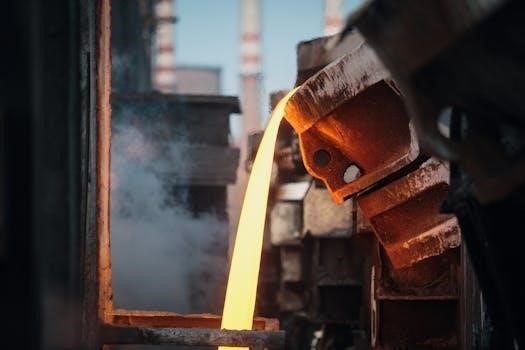This guide provides solutions for common Rheem gas furnace issues, helping you diagnose problems effectively. Learn about error codes and when to seek professional help. Discover key features, maintenance tips, and techniques to keep your heating system running efficiently.

Rheem furnaces are designed with several key components that work in tandem to provide reliable heating for homes. The specific model determines the furnace’s capacity and efficiency ratings. These furnaces utilize a heat exchanger that transfers warmth from combustion gases to the air circulating throughout the house. Burners mix gas and air to create the flame, while the blower fan circulates the heated air through the ductwork. Understanding these basic components is crucial for effective troubleshooting. Rheem furnaces may also feature either a traditional pilot light or a more modern electronic igniter system. Older models might have continuously burning pilot lights, while newer ones use igniters for safer and more efficient operation. Familiarizing yourself with your specific model’s features will greatly assist in diagnosing and resolving any issues that may arise. Regular maintenance, such as changing the air filter, is essential for optimal performance.

Common Problems⁚ Furnace Not Turning On
A furnace that refuses to turn on is a common and frustrating problem. The first step in troubleshooting this issue is to verify that the furnace is receiving power. Check the circuit breaker to ensure it hasn’t tripped and that the furnace is properly plugged into the wall outlet. Next, examine the thermostat settings. Make sure it is set to “heat” and the desired temperature is higher than the ambient room temperature. If the thermostat uses batteries, try replacing them. A faulty thermostat can prevent the furnace from starting. It’s also essential to check the gas supply. Ensure the gas valve is open and that there are no issues with the gas line. A closed valve or a blocked line will prevent the furnace from igniting. Additionally, a dirty burner can hinder the furnace’s ability to start; over time, dust and debris can accumulate, requiring cleaning. Finally, always look for any error codes displayed on the furnace’s control panel, as this can provide specific information about the problem.

Troubleshooting⁚ Ignition Failure and Pilot Light Issues
Ignition problems are a frequent cause of furnace malfunctions. For older Rheem furnaces with pilot lights, a common issue is a faulty thermocouple. The thermocouple ensures the pilot light is lit; if it fails, the gas valve won’t open, preventing heat. Ensure the thermocouple is correctly positioned within the pilot light flame. If it’s not, adjust it. If properly aligned, test the thermocouple using a multimeter; if no current is produced when heated by the pilot flame, it needs replacing. Newer furnaces use an igniter. When the furnace starts, observe if a spark is visible or a clicking sound is heard from the igniter. If there’s no spark or click, check for a faulty igniter. If the igniter is working but the burners still don’t ignite, the problem may lie with the control board, requiring a professional technician’s attention. Always ensure safe practices when checking these components and when handling gas connections.

Addressing Inadequate Heat Output
If your Rheem furnace isn’t producing enough heat, begin by checking if the furnace is running and the fan is working. Make sure the burners are visible and that the flames are burning consistently blue. If everything appears to be functioning but the heat is insufficient, investigate further. A dirty air filter is a common culprit. Replace it with a fresh filter of the correct size to increase airflow through the system. Inspect your ductwork, especially in the attic; collapsed or unsealed ductwork can restrict airflow. Ensure there’s no damage to the ductwork and repair it if necessary. Short cycling during colder periods is normal, but frequent cycling during mild weather can indicate issues like a faulty thermostat or a dirty filter. If changing the filter does not resolve the issue, it is advisable to consult a qualified technician for further analysis of the heat output problem. Make sure to also check the gas supply to the furnace to ensure that it is adequately supplying gas.
Dealing with Strange Noises from the Furnace
Unusual noises emanating from your Rheem furnace should be investigated promptly; Often, the blower fan and its motor are the primary sources of such sounds. The motor itself may be failing, or the bearings on the fan might be wearing out. If the gas valve is humming loudly or the solenoid appears to be the issue, it’s crucial to address it immediately. Be cautious when dealing with electrical and mechanical systems; it is often best to call a trained and qualified technician. Popping sounds, especially intermittently at night, should be looked at. Removing the fan motor and fan requires specialized knowledge and tools. Attempting to do this without the proper expertise might be dangerous. Consulting a professional ensures the safe and effective resolution of the noise issue, preventing any further damage or potential hazards. Remember that any change in the sounds your furnace makes warrants attention. Addressing these issues promptly can save you money and extend the life of your furnace.
Understanding Rheem Furnace Error Codes
Rheem furnaces often utilize error codes to communicate specific issues. These codes, displayed on an LED screen typically located on the control board, act as valuable clues to help diagnose the problem. Your furnace’s user manual should contain a comprehensive list of these error codes along with their corresponding descriptions. If you do not have the manual, you can find charts online outlining the most common Rheem furnace error codes. However, while these codes can be helpful, further diagnosis is often required. A trained Rheem technician is equipped to interpret these codes accurately and perform the necessary repairs, especially if they are related to the control board. The error codes can help pinpoint the location of the problem, and they are not always a DIY fix. It is important to note that the service panel usually covers the display where these codes are shown. Rely on the error codes to guide you, but do not rely on them as the final answer. Remember to seek professional assistance if you have trouble interpreting them.
The Importance of Airflow and Filter Maintenance
Maintaining proper airflow is critical for the efficient operation of your Rheem gas furnace. A key component in ensuring optimal airflow is the furnace’s air filter. A dirty or clogged filter restricts airflow, forcing the furnace to work harder and potentially leading to reduced heating efficiency and even system damage. Regularly changing your furnace filter is a simple yet vital maintenance task that homeowners often overlook. A clean filter allows for proper air circulation, which is essential for distributing warm air throughout your home effectively. Consult your Rheem user manual to determine the correct filter size and type for your furnace. Replacing the filter regularly, often every one to three months, can significantly improve the performance of your heating system. In addition to filter maintenance, it’s important to check for any obstructions in your ductwork. Collapsed or damaged ducts can severely impede airflow, leading to inadequate heating. Inspections of your ductwork are recommended to ensure no blockage.
Blower Fan Issues⁚ Constant Running or Malfunctions
A common issue with Rheem gas furnaces is problems with the blower fan, which can manifest as constant running or complete malfunction. If your blower fan is running continuously, the first step is to check your thermostat settings. Ensure the fan switch is set to “auto” and not “on”. An incorrect fan switch setting is a frequent cause of this problem. If the thermostat setting is correct, a faulty fan limit control switch could be the culprit. If your furnace has a reset on the switch, try resetting it. If that doesn’t work, the switch may need replacement. In some newer furnace models, this switch is incorporated into the control board, which will require professional help. In addition to continuous operation, the blower fan may malfunction entirely. This could stem from a faulty motor or worn-out bearings. These issues often require the expertise of a trained technician. Never attempt to fix these yourself due to electrical and mechanical complexities.
Thermostat Problems and Battery Checks
Thermostat issues are a common cause of heating problems with Rheem furnaces. Many newer thermostats, especially programmable models, rely on batteries for proper operation. If your furnace isn’t responding to thermostat adjustments, begin by checking the batteries. It’s a good practice to replace your thermostat batteries annually, similar to smoke detector batteries. If the thermostat display is dim, blank, or if the furnace is not responding to commands, fresh batteries are a good first step. If changing the batteries doesn’t resolve the problem, a faulty thermostat may be to blame. A malfunctioning thermostat can send incorrect signals to the furnace, preventing it from starting or causing it to cycle improperly. If you suspect a faulty thermostat, you may need to replace it or seek professional assistance. Ensure the thermostat is properly installed and connected to the furnace. A loose wire or incorrect connection could also be the cause of problems. It’s always beneficial to have a professional check the thermostat to rule out any deeper issues.
Gas Supply and Valve Problems
A functional gas supply is crucial for your Rheem gas furnace to operate correctly. If your furnace fails to start or doesn’t produce heat, verify that the gas supply is active. Check that the main gas valve is open and that there are no issues with the gas line itself. A closed gas valve will prevent the furnace from receiving the necessary fuel to ignite. Problems within the gas line can also hinder proper operation; these might include leaks, obstructions, or insufficient pressure. Furthermore, the gas control valve on the furnace itself might be faulty. This valve regulates gas flow to the burners, and if it malfunctions, the furnace won’t be able to produce heat. Issues with the gas valve can sometimes manifest as a humming sound from the furnace. If you suspect a gas supply or valve issue, it is crucial to contact a qualified technician. Working with gas lines and valves can be dangerous and requires professional expertise to ensure safety and proper repair.
When to Call a Professional Technician
While some Rheem furnace issues can be addressed with basic troubleshooting, certain problems require the expertise of a professional HVAC technician. If you’ve tried basic checks like thermostat adjustments, filter replacements, and power supply verification, and your furnace still isn’t working correctly, it’s time to call for help. Issues involving gas lines, such as leaks or valve malfunctions, are particularly dangerous and necessitate professional intervention. Similarly, problems with the furnace’s control board, heat exchanger, or other critical components require specialized knowledge and tools. If you suspect a faulty igniter, a damaged blower motor, or hear unusual noises that persist after basic checks, a technician can diagnose and resolve the underlying cause safely. Error codes displayed on your furnace’s control board often indicate complex issues that also demand professional diagnostics. In general, if you are unsure about the cause of a furnace problem or feel uncomfortable working with electrical or gas components, it’s always best to call a qualified technician. This ensures the safe and efficient repair of your Rheem furnace.
